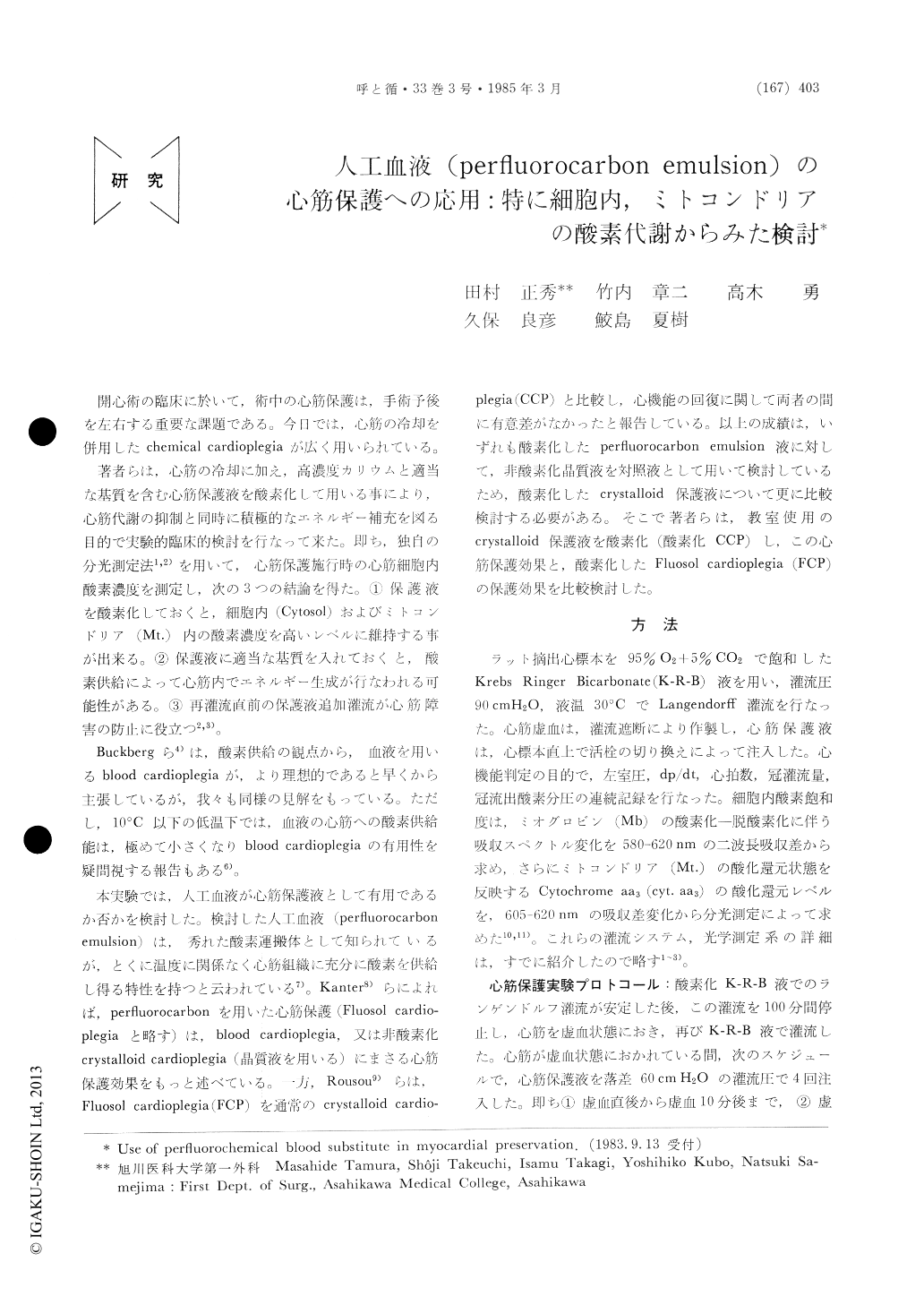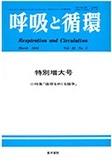Japanese
English
- 有料閲覧
- Abstract 文献概要
- 1ページ目 Look Inside
開心術の臨床に於いて,術中の心筋保護は,手術予後を左右する重要な課題である。今日では,心筋の冷却を併用したchemical cardioplegiaが広く用いられている。
著者らは,心筋の冷却に加え,高濃度カリウムと適当な基質を含む心筋保護液を酸素化して用いる事により,心筋代謝の抑制と同時に積極的なエネルギー補充を図る目的で実験的臨床的検討を行なって来た。即ち,独自の分光測定法1,2)を用いて,心筋保護施行時の心筋細胞内酸素濃度を測定し,次の3つの結論を得た。①保護液を酸素化しておくと,細胞内(Cytosol)およびミトコンドリア(Mt.)内の酸素濃度を高いレベルに維持する事が出来る。②保護液に適当な基質を入れておくと,酸素供給によって心筋内でエネルギー生成が行なわれる可能性がある。③再灌流直前の保護液追加灌流が心筋障害の防止に役立つ2,3)。
Our previous studies have demonstrated that oxy-genated crystalloid cardioplegic solutions better pro-tect myocardial cell during ischemia than non-oxygenated solutions.
This study compares myocardial protection using our oxygenated crystalloid cardioplegia (acetate-potasium solution, PO2 550-680 mmHg) with oxygen-carrying solution of fluorocarbon (20% FC-13 perfluorocarbon emulsion, PO2 450-550 mmHg), each containing 25-26 mEq/L of potassium ions.
Twenty isolated rat hearts were perfused with oxygenated Krebs-Ringer bicarbonate solution using Langendorff's perfusion method and were subjected to 100 minutes of ischemic arrest at 25℃ with inter-mittent infusion of hypothermic cardioplegic solu-tions.
All hemodynamic variables such as LVP, LV dp dt, HR were similar in Fluosol Cardioplegia 〔FCP〕and in crystalloid cardioplegia (CCP) group at 45-60 minutes of reperfusion and recovery.
The stone heart syndrome was noted after reper-fusion in two out of ten hearts in FCP group but none in 7 hearts in CCP group.
Coronary flow on each cardioplegic infusion was significantly lower in FCP group, compared with CCP group, indicating an elevation of coronary vascular resistance in FCP.
Myocardial oxygen consumption was approximate-ly 2 times greater for FCP group than for CCP group during myocardial protection, but there was no significant difference between both groups at reperfusion and recovery period.
The oxy-deoxygenation of myoglobin and the oxidation-reduction level of Cyt. aa3 were measured by spectrometric analysis to evaluate the oxygen metabolism and biochemical reactions in cytosole and mitochondria.
On each cardioplegic infusion, the redox state of cytosol and mitochondria had progressively shifted toward reduction in FCP group, however in CCP group that was maintained in pre-ischemic aerobic condition.
At recovery phase after reperfusion, the recovery of redox state in cytosol and mitochondria to aero-bic level was markedly delayed in FCP group, com-pared with the prompt recovery in CCP group.
Levels of myocardial glutathipne leakage were significantly higher in FCP group on each cardio-plegic infusion, compared with CCP group and fur-ther trends were noted during recovery phase, indi-cating more severe myocardial cellular damage in FCP group.
Through this experimental study, we concluded that the myocardial protection afforded by fluosol cardioplegic solution does not exceed that provided by the oxygenated crystalloid solution and that further work is needed to use fluorocarbon more effectively in myocardial preservation.

Copyright © 1985, Igaku-Shoin Ltd. All rights reserved.


